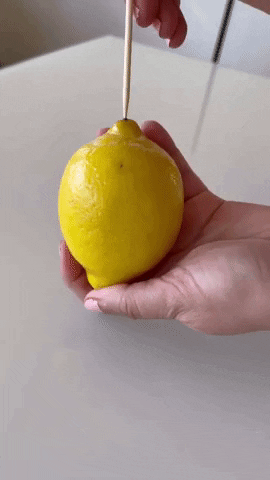If you want to efficiently extract lemon juice without cutting the lemons in half, here’s the correct method. The common practice of just squeezing a cut lemon can often result in limited juice output, as well as potential hand injuries.
In this article, we will guide you through a better technique for extracting lemon juice.

The traditional method may not be the most effective
Tips for extracting a lot of lemon juice without cutting in half
To begin, keep the lemon intact and roll it on a flat surface for about 1 minute, gently applying pressure to break the peel. Carefully squeeze the rolled lemon in your palm for a while, avoiding any potential contact with the peel’s oil.

You can use paper to wrap the lemon to avoid contact with the peel’s oil
Next, take a wooden skewer (typically used for meat skewers) and vertically poke a line from the stem to the bottom of the lemon.

Use the skewer to poke the lemon as shown in the image
Finally, remove the skewer and firmly squeeze the lemon with your hand to extract all of the juice.

You can extract all the juice without using a knife
This technique can be applied to both green and yellow lemons. Additionally, when dealing with fruits that have seeds, rolling and squeezing them on a flat surface for 1-2 minutes beforehand helps to break apart the seeds and yield more juice.
What is the difference between green lemons and yellow lemons?
This is a common question. Both green lemons and yellow lemons are popular citrus fruits with various culinary uses. They are quite similar nutritionally and offer several health benefits.
1. Taste
Both types of lemons are acidic and sour, but yellow lemons tend to be sweeter and more fragrant, while green lemons have a sharp and slightly bitter taste.
Due to this taste difference, green lemons are often used as a seasoning for savory dishes, while the sweetness of yellow lemons allows for broader applications in both savory and sweet dishes.
2. Vitamin C content and minerals







































